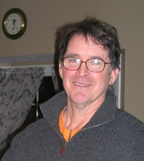John Hermanson, PhD

Department of Biomedical Sciences
Associate Professor Emeritus of Anatomy
Department of Biomedical Sciences
Cornell University College of Veterinary Medicine
S2 080 Schurman Hall, Box 18
Ithaca, NY 14853-6401
Office: 607-253-3542
Email: jwh6@cornell.edu
Research Interest
My research focuses on the theme of muscle biology, currently spanning from the gross to the molecular levels of analysis. I have a long standing interest in the flight of bats, in part motivated out of curiosity about how bat muscles produce high frequency, powerful movements, and yet remain remarkably resistant to fatigue. Our studies have identified recruitment patterns, histochemical profiles, and physiological characteristics of the major flight muscles in a number of bat species. Recently, our laboratory has been performing an integrated structural-functional analysis of the appendicular muscles in horses and bats, as well as in a diversity of other species. The goal of these studies is to develop a comparative biology of muscle in several of Nature's better "athletes." For horses, our goal is not only to understand the biomechanics of locomotion. But, we also look at possible muscle involvement in gait abnormalities. In both horses and bats, we have sought to correlate specializations of the major contractile protein, myosin, with phylogenetic or architectural/functional constraints. In all these somewhat divergent studies, the major themes come back to the role of muscle groups in locomotion, and the elucidation of interactions between nerves and muscles in affecting the phenotype of mature muscle.
Education
- PhD 1983 Zoology at University of Florida
- MS 1978 Biological Sciences, Northern Arizona University
- BS 1975 Zoology, University of Massachusetts, Amherst
Biography/Professional Experience
Has been teaching anatomy at the Veterinary College since 1987.
Publications
- Surgical Anatomy of Celiotomy Approaches to the Stomach in the Common Snapping Turtle (Chelydra Serpentina). Jimenez IA, Hermanson JW, Childs-Sanford SE. J Zoo Wildl Med. 2019 Mar 1;50(1):82-88. doi: 10.1638/2018-0114. PMID: 31120665
- The crouching of the shrew: Mechanical consequences of limb posture in small mammals. Riskin DK, Kendall CJ, Hermanson JW. PeerJ. 2016 Jun 20;4:e2131. doi: 10.7717/peerj.2131. eCollection 2016. PMID 27413633
- Chemical Prey Luring in Jackson's Chameleons. Preest MR, Ward MJ, Poon T, Hermanson JW. Physiol Biochem Zool. 2016 Mar-Apr;89(2):110-7. doi: 10.1086/685455. Epub 2016 Feb 3. PMID: 27082721
- Effects of Functional Electrical Stimulation on Denervated Laryngeal Muscle in a Large Animal Model. Cheetham J, Perkins JD, Jarvis JC, Cercone M, Maw M, Hermanson JW, Mitchell LM, Piercy RJ, Ducharme NG. Artif Organs. 2015 Oct;39(10):876-85. doi: 10.1111/aor.12624. PMID: 26471139
- Frequency dependence of power and its implications for contracile function of muscle fibers from the digital flexors of horses. Butcher MT, Bertram JE, Syme DA, Hermanson JW, Chase PB. Physiol Rep. 2014 Oct7;2(10):e12174. doi: 10.14814/phy2.12174. Print 2014 Oct 1. PMID: 25293602
- Anatomic and neuromuscular characterisation of the equine cricothyroid muscle. Reesink HL, Hermanson JW, Cheetham J, Mu L, Mitchell LM, Soderholm LV, Ducharme NG. Equine Vet J. 2013 Sep;45(5):630-6. doi: 10.1111/evj.12023. Epub 2013 Jan 24. PMID: 23346975
- Considerations for pacing of the cricoarytenoid dorsalis muscle by neuroprosthesis in horses. Ducharme NG, Cheetham J, Sanders I, Hermanson JW, Hackett RP, Soderholm LV, Mitchell LM. Equine Vet J. 2010 Sep;42(6):534-40. doi: 10.1111/j.2042-3306.2010.00115.x. PMID: 20716194
- Contractile properties of muscle fibers from the deep and superficial digital flexors of horses. Butcher MT, Chase PB, Hermanson JW, Clark AN, Brunet NM, Bertram JE. Am J Physiol Regul Integr Comp Physiol. 2010 Oct;299(4):R996-R1005. doi: 10.1152/ajpregu.00510.2009. Epub 2010 Aug 11. PMID: 20702801
- Echolocation call production during aerial and terrestrial locomotion by New Zealand's enigmatic lesser short-tailed bay, Mystacina tuberculata. Parsons S, Riskin DK, Hermanson JW. J Exp Biol. 2010 Feb 15;213(4):551-7. doi: 10.1242/jeb.039008. PMID: 20118305
- Role of the hypoglossal nerve in equine nasopharyngeal stability. Cheetham J, Pigott JH, Hermanson JW, Campoy L, Soderholm LV, Thorson LM, Ducharme NG. J Appl Physiol (1985). 2009 Aug;107(2):471-7. doi: 10.1152/japplphysiol.91177.2008. Epub 2009 Jun 4. PMID: 19498094
![]() Browse PubMed for a complete listing of Dr. Hermanson's publications
Browse PubMed for a complete listing of Dr. Hermanson's publications
Awards and Honors
TBD
Professional/Academic Affiliations
Professional Affiliations:
American Association for the Advancement of Science
American Association of Anatomists
American Society of Mammalogists
North American Bat Research Symposium
Society for Neuroscience
Society of Vertebrate Paleontology
Academic Affiliations:
Department of Biomedical Sciences
Graduate Field of Zoology and Wildlife Conservation


